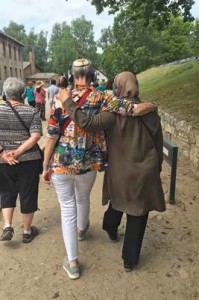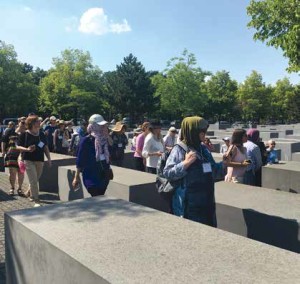Tag : SOSS
November 4, 2019 by admin
Lean on Me: Muslim & Jewish Sisterhood at Auschwitz

Sisterhood of Salaam Shalom Jew and Muslim at Auschwitz.
Photo by Nazli Chaudhry
Not your usual Holocaust learning experience—eight days with 50 American Muslim and Jewish women in Berlin, Warsaw, Krakow and Auschwitz in July. We were with the Sisterhood of Salaam Shalom, a grassroots American organization with the bridge-building goal of bringing Jewish and Muslim women together to get to know each other and stand up together to hatred. (Note: membership has more than tripled since Trump’s election.) Our resource person for the trip was Mehnaz M. Afridi, associate professor at Manhattan College, director of the Holocaust, Genocide, and Interfaith Education Center and author of the book Shoah Through Muslim Eyes.
In Berlin, we were fêted and entertained at a mosque, starting with the sound of a woman’s voice reciting from the Koran, then dinner with Muslims and Christians involved in community projects. We worshipped at the remains of one of the great Berlin synagogues (now headed by a woman rabbi) and saw the building where Regina Jonas once lived; she was the world’s first woman ordained as a rabbi, and she was killed at Auschwitz.
We went through a thousand years of Polish Jewish history at Warsaw’s new POLIN Museum, where we got into a fight with our Polish guide who told us that the Poles had suffered as much as the Jews. Jan, a Jewish Pole, then told me that three million Christian Poles were killed by the Germans. When I shared this with our group, Afridi doubted that number. (“Maybe only 500,000.” Seam- ingly, she falls into the same fallacy she points out in her book, that Muslim countries deny or diminish the Shoah by saying, “Only a million Jews were killed by Hitler.”) I was learning how complicated things are, and how hard it is to change mindset. Statistics remain problematic, but historians have little doubt that indeed between two and three million Polish Christians died during World War II, the large majority from German repression and occupation.

SOSS Building Bridges trip to Berlin and Poland at Berlin’s Memorial to
the Murdered Jews of Europe.
Photo by Nazli Chaudhry
In Warsaw, we visited the city’s one synagogue that survived the war. A beautiful, still-functioning Orthodox synagogue, with an American rabbi from Ohio who knows our trip’s co-leader. In a country with few Muslims, this synagogue is where we met the Tatar Muslim who’d come from Bialystok to speak with us. Muslim Polish history goes back 700 years, but it’s a thin thread. As one academic put it, Poles fear Muslims without ever having met one— a case of “Platonic Islamophobia.”
A decade ago, this lack of diversity among visitors to Auschwitz left future SOSS co-founder Sheryl Olitzky feeling the need to bring people who didn’t look like her—brown, black, non-Jewish, openly LGBTQ —into the post-Auschwitz conversation. And so we were heading for Auschwitz with Olitzky and her SOSS co-founder, Atiya Aftab. And our busload of Muslim and Jewish SOSS members were brown, white, and some first-generation Americans.
But first, Krakow’s old city, undamaged by the war. Its Jews deported, its buildings preserved, Kazimierz, the old Jewish quarter, is now awash in tourism thanks to “Schindler’s List” film locations. Klezmer music, chicken soup and cholent served up by non-Jews. And the unnerving sight of jitneys advertising tours to Auschwitz. I felt I was in Hitler’s planned museum of the extinct race. But now our dining room at Klezmer-Hois Restauracja was filled with Jewish and Muslim women taking selfies. And at the local JCC, we saw proof of a small, reborn Jewish community.
Finally, Auschwitz and Birkenau. Concentration and extermination camps—an endless expanse in the blazing heat. As we left the bus, one of my Muslim sisters said to me, softly, “We’re here to support you.” I was surprised, and touched.
After hours plugged into headphones listening to our knowledgeable, restrained Polish guide, we reached the small building where we stood in a circle for a memorial service with Jewish and Muslim prayers. This was where many of us spoke the names of family and friends’ family members murdered in the Shoah.
Walking back to the bus, in the shade of a small grove of trees, I came upon a cluster of Muslim women from our sisterhood gathered in afternoon prayer, their bright colored head scarves standing out against the green leaves. I was riveted by this image without cliché—Muslim women at prayer in Auschwitz. And I did feel supported.
- No Comments
 Please wait...
Please wait...